Report on Business Expansion: Strategic HRM and Sustainability
VerifiedAdded on 2023/05/28
|11
|2361
|223
Report
AI Summary
This report provides a comprehensive analysis of Human Resource Management (HRM) strategies crucial for business expansion and sustainability within a technology company specializing in electronic devices. It details essential job requirements such as certifications, previous work experience, and external influences, and discusses their impact on staffing through recruitment questions and advertisements. The report outlines a long-term recruitment plan encompassing job opening identification, target group selection, and candidate meetings. Branding strategies like brand positioning, name selection, and development are explored, along with communication methods for applicant outreach. Employee selection processes, including online examinations and personal interviews, are discussed, emphasizing selection criteria such as educational qualifications, work experience, skills, age limit, and training. The analysis extends to assessment methods like KSA-based and task-based evaluations, examining their validity and reliability. Finally, the report identifies key job predictors for assessing KSAOs, including educational qualifications, past behavior, cognitive ability, and conscientiousness, concluding that effective HRM practices are essential for maximizing employee performance and achieving strategic objectives during business expansion.
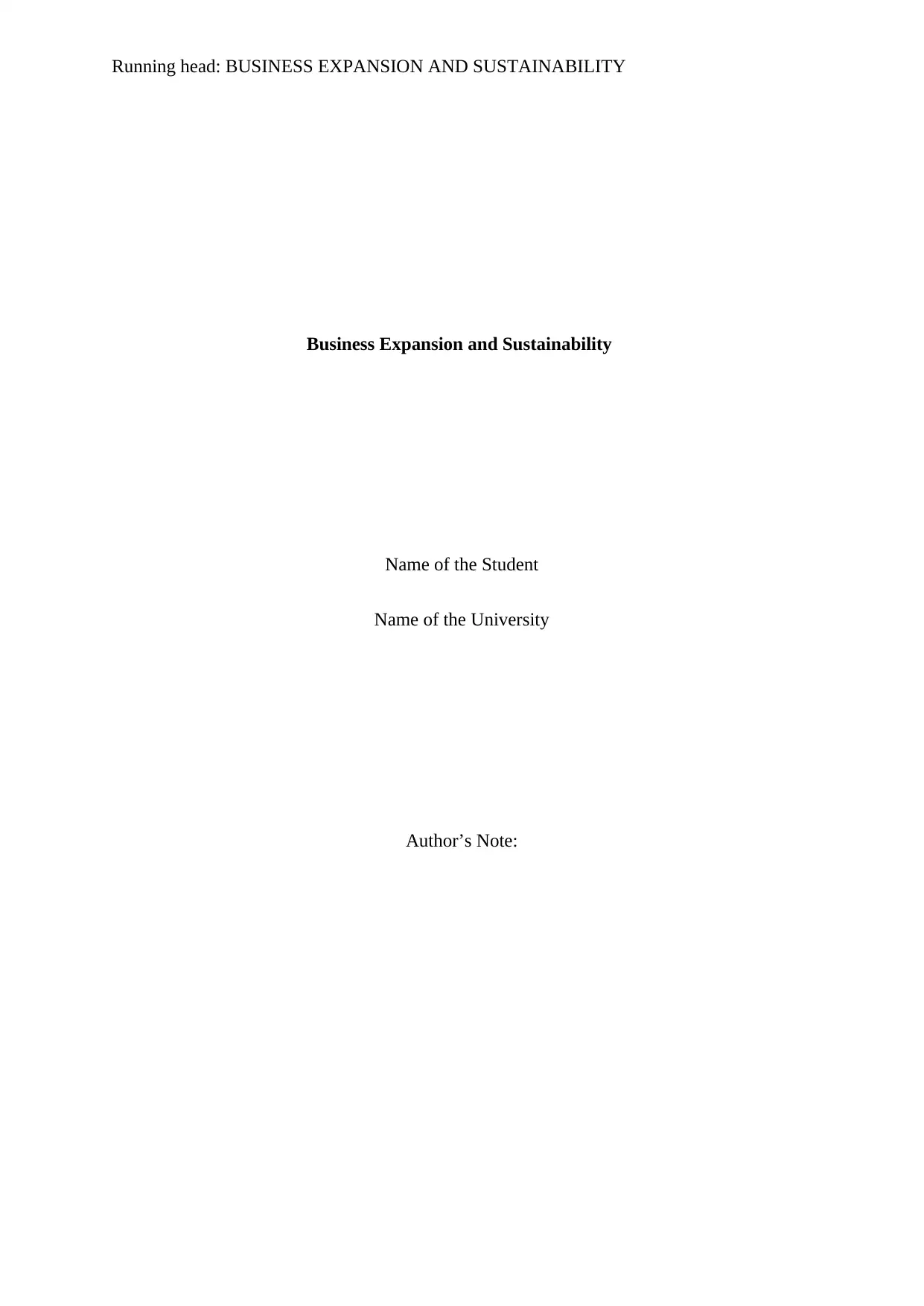
Running head: BUSINESS EXPANSION AND SUSTAINABILITY
Business Expansion and Sustainability
Name of the Student
Name of the University
Author’s Note:
Business Expansion and Sustainability
Name of the Student
Name of the University
Author’s Note:
Paraphrase This Document
Need a fresh take? Get an instant paraphrase of this document with our AI Paraphraser
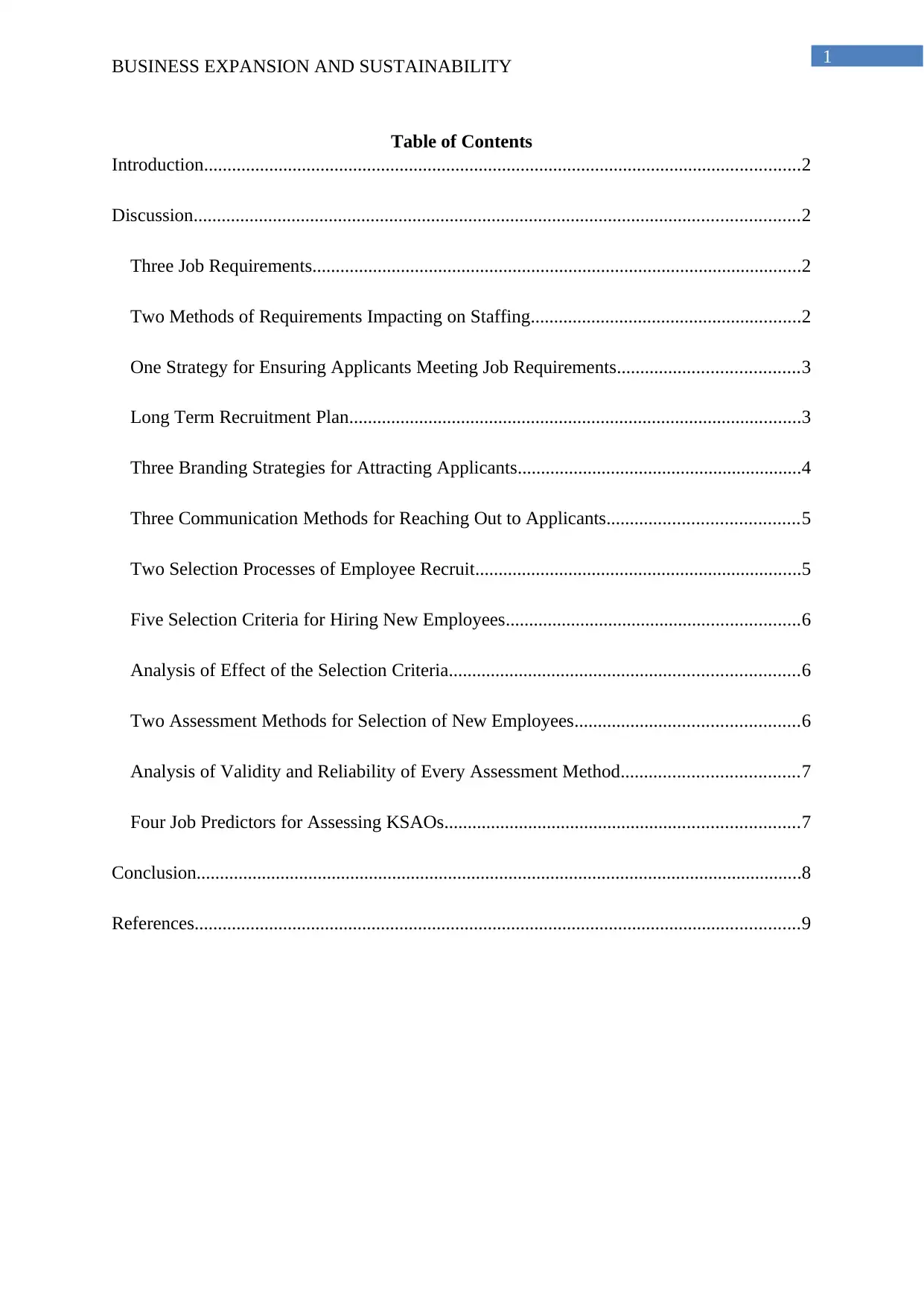
1
BUSINESS EXPANSION AND SUSTAINABILITY
Table of Contents
Introduction................................................................................................................................2
Discussion..................................................................................................................................2
Three Job Requirements.........................................................................................................2
Two Methods of Requirements Impacting on Staffing..........................................................2
One Strategy for Ensuring Applicants Meeting Job Requirements.......................................3
Long Term Recruitment Plan.................................................................................................3
Three Branding Strategies for Attracting Applicants.............................................................4
Three Communication Methods for Reaching Out to Applicants.........................................5
Two Selection Processes of Employee Recruit......................................................................5
Five Selection Criteria for Hiring New Employees...............................................................6
Analysis of Effect of the Selection Criteria...........................................................................6
Two Assessment Methods for Selection of New Employees................................................6
Analysis of Validity and Reliability of Every Assessment Method......................................7
Four Job Predictors for Assessing KSAOs............................................................................7
Conclusion..................................................................................................................................8
References..................................................................................................................................9
BUSINESS EXPANSION AND SUSTAINABILITY
Table of Contents
Introduction................................................................................................................................2
Discussion..................................................................................................................................2
Three Job Requirements.........................................................................................................2
Two Methods of Requirements Impacting on Staffing..........................................................2
One Strategy for Ensuring Applicants Meeting Job Requirements.......................................3
Long Term Recruitment Plan.................................................................................................3
Three Branding Strategies for Attracting Applicants.............................................................4
Three Communication Methods for Reaching Out to Applicants.........................................5
Two Selection Processes of Employee Recruit......................................................................5
Five Selection Criteria for Hiring New Employees...............................................................6
Analysis of Effect of the Selection Criteria...........................................................................6
Two Assessment Methods for Selection of New Employees................................................6
Analysis of Validity and Reliability of Every Assessment Method......................................7
Four Job Predictors for Assessing KSAOs............................................................................7
Conclusion..................................................................................................................................8
References..................................................................................................................................9
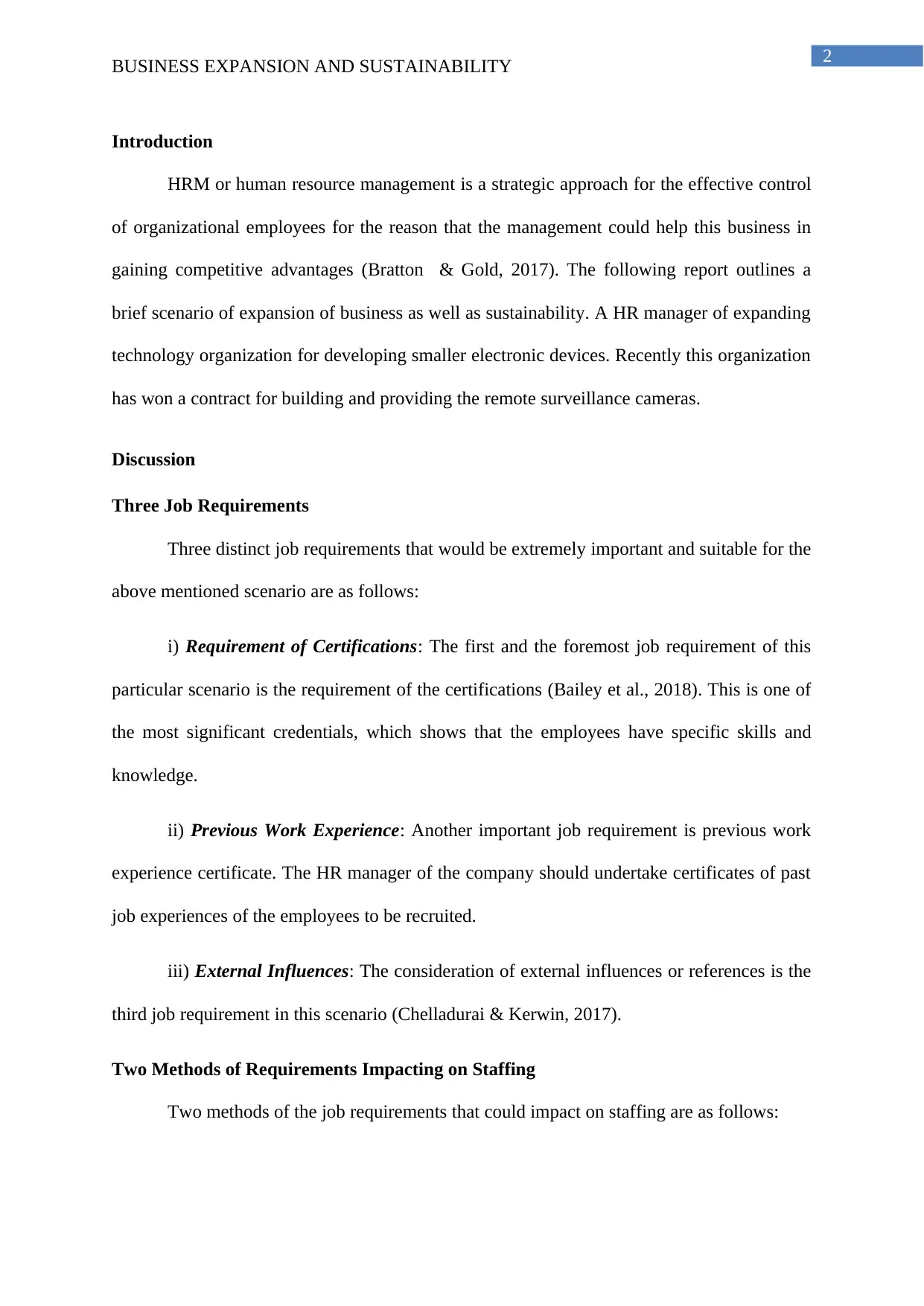
2
BUSINESS EXPANSION AND SUSTAINABILITY
Introduction
HRM or human resource management is a strategic approach for the effective control
of organizational employees for the reason that the management could help this business in
gaining competitive advantages (Bratton & Gold, 2017). The following report outlines a
brief scenario of expansion of business as well as sustainability. A HR manager of expanding
technology organization for developing smaller electronic devices. Recently this organization
has won a contract for building and providing the remote surveillance cameras.
Discussion
Three Job Requirements
Three distinct job requirements that would be extremely important and suitable for the
above mentioned scenario are as follows:
i) Requirement of Certifications: The first and the foremost job requirement of this
particular scenario is the requirement of the certifications (Bailey et al., 2018). This is one of
the most significant credentials, which shows that the employees have specific skills and
knowledge.
ii) Previous Work Experience: Another important job requirement is previous work
experience certificate. The HR manager of the company should undertake certificates of past
job experiences of the employees to be recruited.
iii) External Influences: The consideration of external influences or references is the
third job requirement in this scenario (Chelladurai & Kerwin, 2017).
Two Methods of Requirements Impacting on Staffing
Two methods of the job requirements that could impact on staffing are as follows:
BUSINESS EXPANSION AND SUSTAINABILITY
Introduction
HRM or human resource management is a strategic approach for the effective control
of organizational employees for the reason that the management could help this business in
gaining competitive advantages (Bratton & Gold, 2017). The following report outlines a
brief scenario of expansion of business as well as sustainability. A HR manager of expanding
technology organization for developing smaller electronic devices. Recently this organization
has won a contract for building and providing the remote surveillance cameras.
Discussion
Three Job Requirements
Three distinct job requirements that would be extremely important and suitable for the
above mentioned scenario are as follows:
i) Requirement of Certifications: The first and the foremost job requirement of this
particular scenario is the requirement of the certifications (Bailey et al., 2018). This is one of
the most significant credentials, which shows that the employees have specific skills and
knowledge.
ii) Previous Work Experience: Another important job requirement is previous work
experience certificate. The HR manager of the company should undertake certificates of past
job experiences of the employees to be recruited.
iii) External Influences: The consideration of external influences or references is the
third job requirement in this scenario (Chelladurai & Kerwin, 2017).
Two Methods of Requirements Impacting on Staffing
Two methods of the job requirements that could impact on staffing are as follows:
⊘ This is a preview!⊘
Do you want full access?
Subscribe today to unlock all pages.

Trusted by 1+ million students worldwide
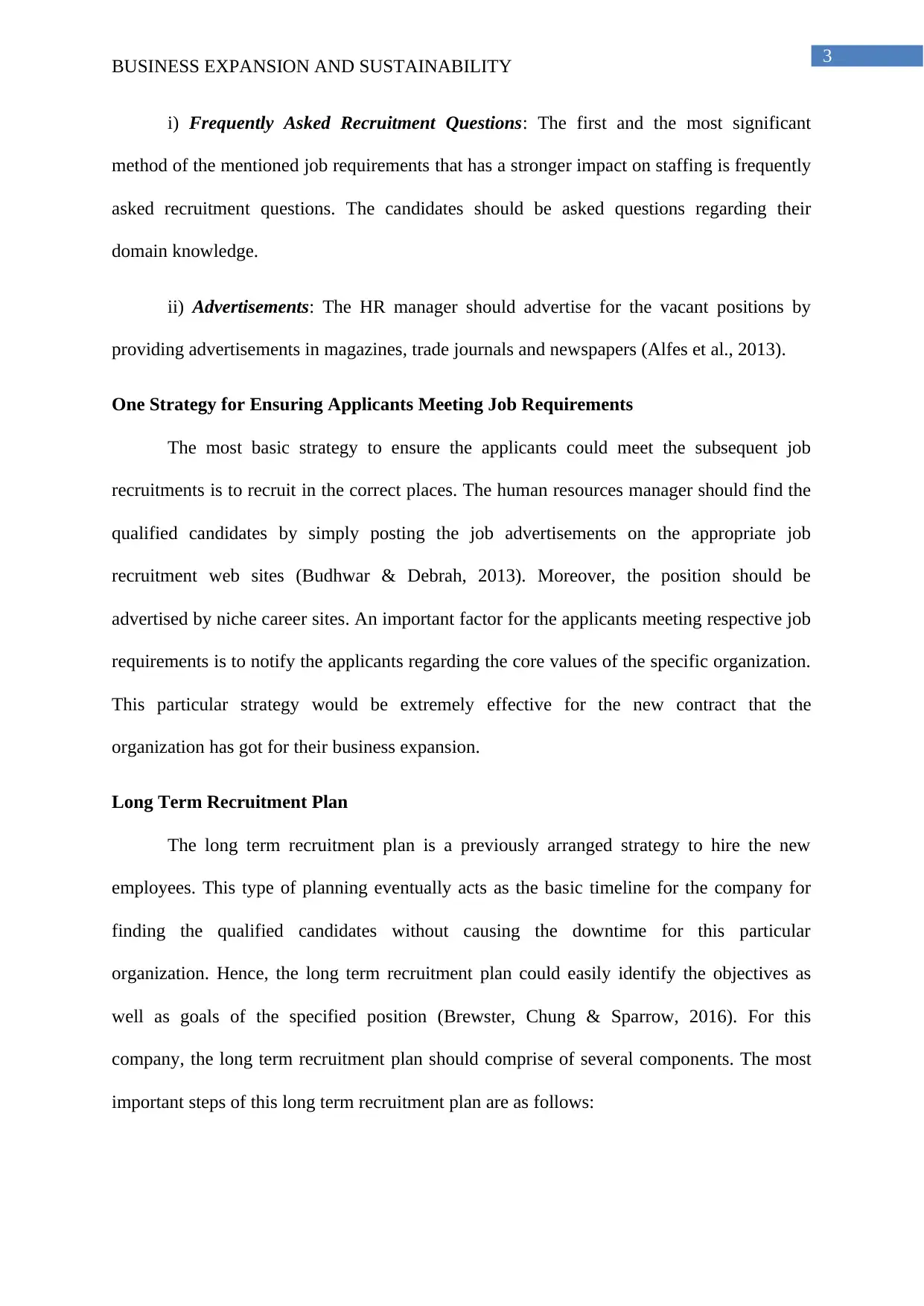
3
BUSINESS EXPANSION AND SUSTAINABILITY
i) Frequently Asked Recruitment Questions: The first and the most significant
method of the mentioned job requirements that has a stronger impact on staffing is frequently
asked recruitment questions. The candidates should be asked questions regarding their
domain knowledge.
ii) Advertisements: The HR manager should advertise for the vacant positions by
providing advertisements in magazines, trade journals and newspapers (Alfes et al., 2013).
One Strategy for Ensuring Applicants Meeting Job Requirements
The most basic strategy to ensure the applicants could meet the subsequent job
recruitments is to recruit in the correct places. The human resources manager should find the
qualified candidates by simply posting the job advertisements on the appropriate job
recruitment web sites (Budhwar & Debrah, 2013). Moreover, the position should be
advertised by niche career sites. An important factor for the applicants meeting respective job
requirements is to notify the applicants regarding the core values of the specific organization.
This particular strategy would be extremely effective for the new contract that the
organization has got for their business expansion.
Long Term Recruitment Plan
The long term recruitment plan is a previously arranged strategy to hire the new
employees. This type of planning eventually acts as the basic timeline for the company for
finding the qualified candidates without causing the downtime for this particular
organization. Hence, the long term recruitment plan could easily identify the objectives as
well as goals of the specified position (Brewster, Chung & Sparrow, 2016). For this
company, the long term recruitment plan should comprise of several components. The most
important steps of this long term recruitment plan are as follows:
BUSINESS EXPANSION AND SUSTAINABILITY
i) Frequently Asked Recruitment Questions: The first and the most significant
method of the mentioned job requirements that has a stronger impact on staffing is frequently
asked recruitment questions. The candidates should be asked questions regarding their
domain knowledge.
ii) Advertisements: The HR manager should advertise for the vacant positions by
providing advertisements in magazines, trade journals and newspapers (Alfes et al., 2013).
One Strategy for Ensuring Applicants Meeting Job Requirements
The most basic strategy to ensure the applicants could meet the subsequent job
recruitments is to recruit in the correct places. The human resources manager should find the
qualified candidates by simply posting the job advertisements on the appropriate job
recruitment web sites (Budhwar & Debrah, 2013). Moreover, the position should be
advertised by niche career sites. An important factor for the applicants meeting respective job
requirements is to notify the applicants regarding the core values of the specific organization.
This particular strategy would be extremely effective for the new contract that the
organization has got for their business expansion.
Long Term Recruitment Plan
The long term recruitment plan is a previously arranged strategy to hire the new
employees. This type of planning eventually acts as the basic timeline for the company for
finding the qualified candidates without causing the downtime for this particular
organization. Hence, the long term recruitment plan could easily identify the objectives as
well as goals of the specified position (Brewster, Chung & Sparrow, 2016). For this
company, the long term recruitment plan should comprise of several components. The most
important steps of this long term recruitment plan are as follows:
Paraphrase This Document
Need a fresh take? Get an instant paraphrase of this document with our AI Paraphraser
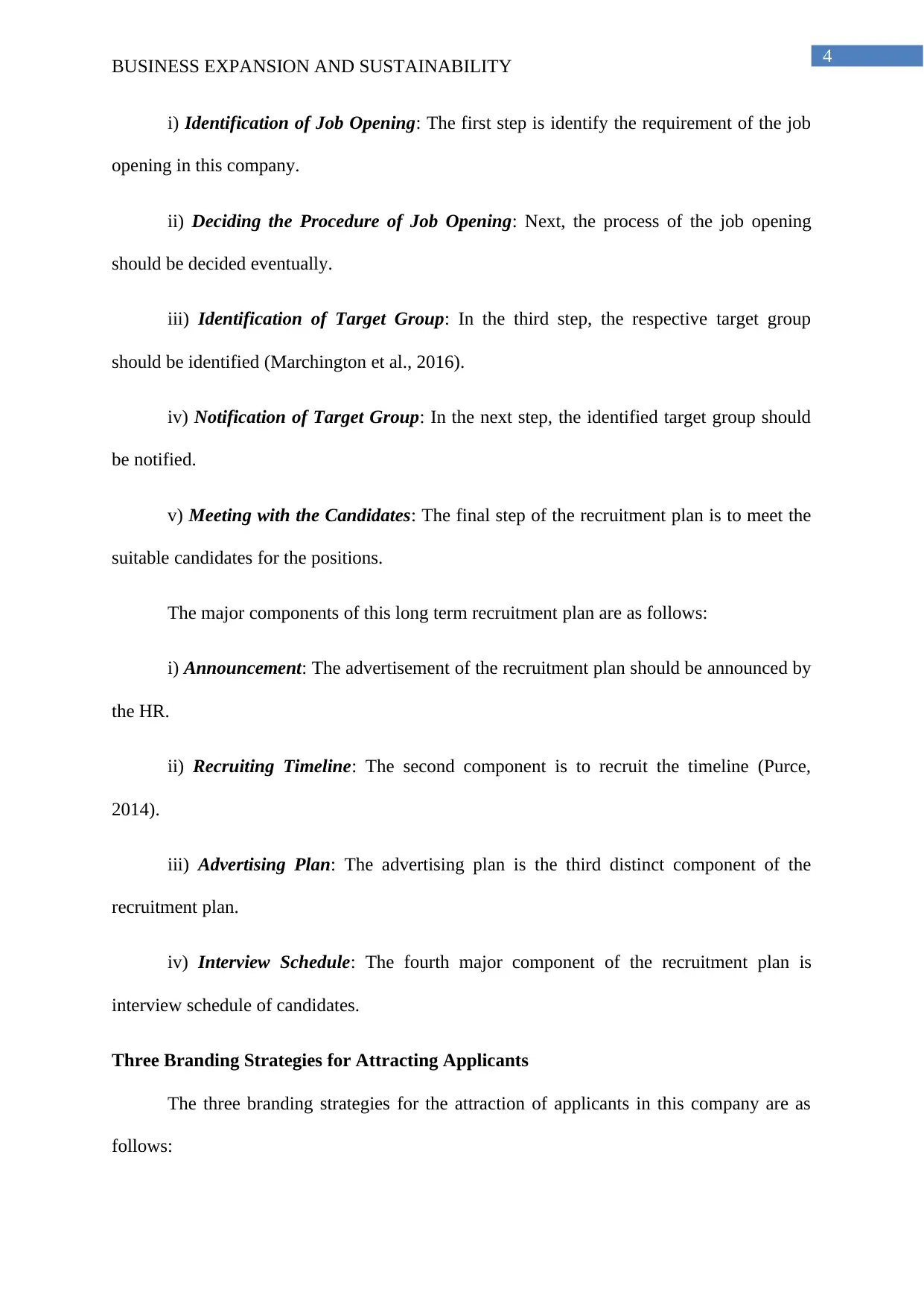
4
BUSINESS EXPANSION AND SUSTAINABILITY
i) Identification of Job Opening: The first step is identify the requirement of the job
opening in this company.
ii) Deciding the Procedure of Job Opening: Next, the process of the job opening
should be decided eventually.
iii) Identification of Target Group: In the third step, the respective target group
should be identified (Marchington et al., 2016).
iv) Notification of Target Group: In the next step, the identified target group should
be notified.
v) Meeting with the Candidates: The final step of the recruitment plan is to meet the
suitable candidates for the positions.
The major components of this long term recruitment plan are as follows:
i) Announcement: The advertisement of the recruitment plan should be announced by
the HR.
ii) Recruiting Timeline: The second component is to recruit the timeline (Purce,
2014).
iii) Advertising Plan: The advertising plan is the third distinct component of the
recruitment plan.
iv) Interview Schedule: The fourth major component of the recruitment plan is
interview schedule of candidates.
Three Branding Strategies for Attracting Applicants
The three branding strategies for the attraction of applicants in this company are as
follows:
BUSINESS EXPANSION AND SUSTAINABILITY
i) Identification of Job Opening: The first step is identify the requirement of the job
opening in this company.
ii) Deciding the Procedure of Job Opening: Next, the process of the job opening
should be decided eventually.
iii) Identification of Target Group: In the third step, the respective target group
should be identified (Marchington et al., 2016).
iv) Notification of Target Group: In the next step, the identified target group should
be notified.
v) Meeting with the Candidates: The final step of the recruitment plan is to meet the
suitable candidates for the positions.
The major components of this long term recruitment plan are as follows:
i) Announcement: The advertisement of the recruitment plan should be announced by
the HR.
ii) Recruiting Timeline: The second component is to recruit the timeline (Purce,
2014).
iii) Advertising Plan: The advertising plan is the third distinct component of the
recruitment plan.
iv) Interview Schedule: The fourth major component of the recruitment plan is
interview schedule of candidates.
Three Branding Strategies for Attracting Applicants
The three branding strategies for the attraction of applicants in this company are as
follows:
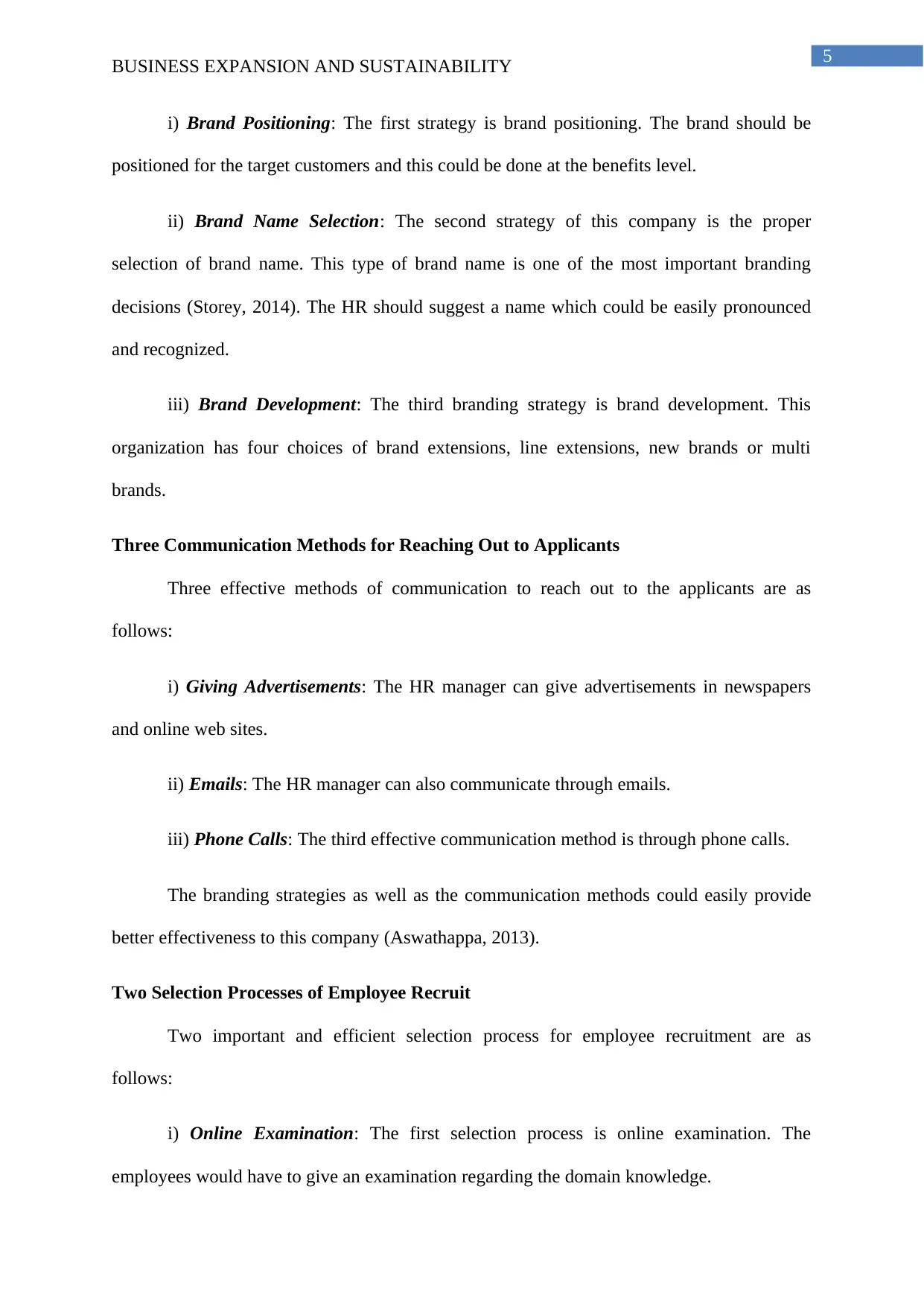
5
BUSINESS EXPANSION AND SUSTAINABILITY
i) Brand Positioning: The first strategy is brand positioning. The brand should be
positioned for the target customers and this could be done at the benefits level.
ii) Brand Name Selection: The second strategy of this company is the proper
selection of brand name. This type of brand name is one of the most important branding
decisions (Storey, 2014). The HR should suggest a name which could be easily pronounced
and recognized.
iii) Brand Development: The third branding strategy is brand development. This
organization has four choices of brand extensions, line extensions, new brands or multi
brands.
Three Communication Methods for Reaching Out to Applicants
Three effective methods of communication to reach out to the applicants are as
follows:
i) Giving Advertisements: The HR manager can give advertisements in newspapers
and online web sites.
ii) Emails: The HR manager can also communicate through emails.
iii) Phone Calls: The third effective communication method is through phone calls.
The branding strategies as well as the communication methods could easily provide
better effectiveness to this company (Aswathappa, 2013).
Two Selection Processes of Employee Recruit
Two important and efficient selection process for employee recruitment are as
follows:
i) Online Examination: The first selection process is online examination. The
employees would have to give an examination regarding the domain knowledge.
BUSINESS EXPANSION AND SUSTAINABILITY
i) Brand Positioning: The first strategy is brand positioning. The brand should be
positioned for the target customers and this could be done at the benefits level.
ii) Brand Name Selection: The second strategy of this company is the proper
selection of brand name. This type of brand name is one of the most important branding
decisions (Storey, 2014). The HR should suggest a name which could be easily pronounced
and recognized.
iii) Brand Development: The third branding strategy is brand development. This
organization has four choices of brand extensions, line extensions, new brands or multi
brands.
Three Communication Methods for Reaching Out to Applicants
Three effective methods of communication to reach out to the applicants are as
follows:
i) Giving Advertisements: The HR manager can give advertisements in newspapers
and online web sites.
ii) Emails: The HR manager can also communicate through emails.
iii) Phone Calls: The third effective communication method is through phone calls.
The branding strategies as well as the communication methods could easily provide
better effectiveness to this company (Aswathappa, 2013).
Two Selection Processes of Employee Recruit
Two important and efficient selection process for employee recruitment are as
follows:
i) Online Examination: The first selection process is online examination. The
employees would have to give an examination regarding the domain knowledge.
⊘ This is a preview!⊘
Do you want full access?
Subscribe today to unlock all pages.

Trusted by 1+ million students worldwide
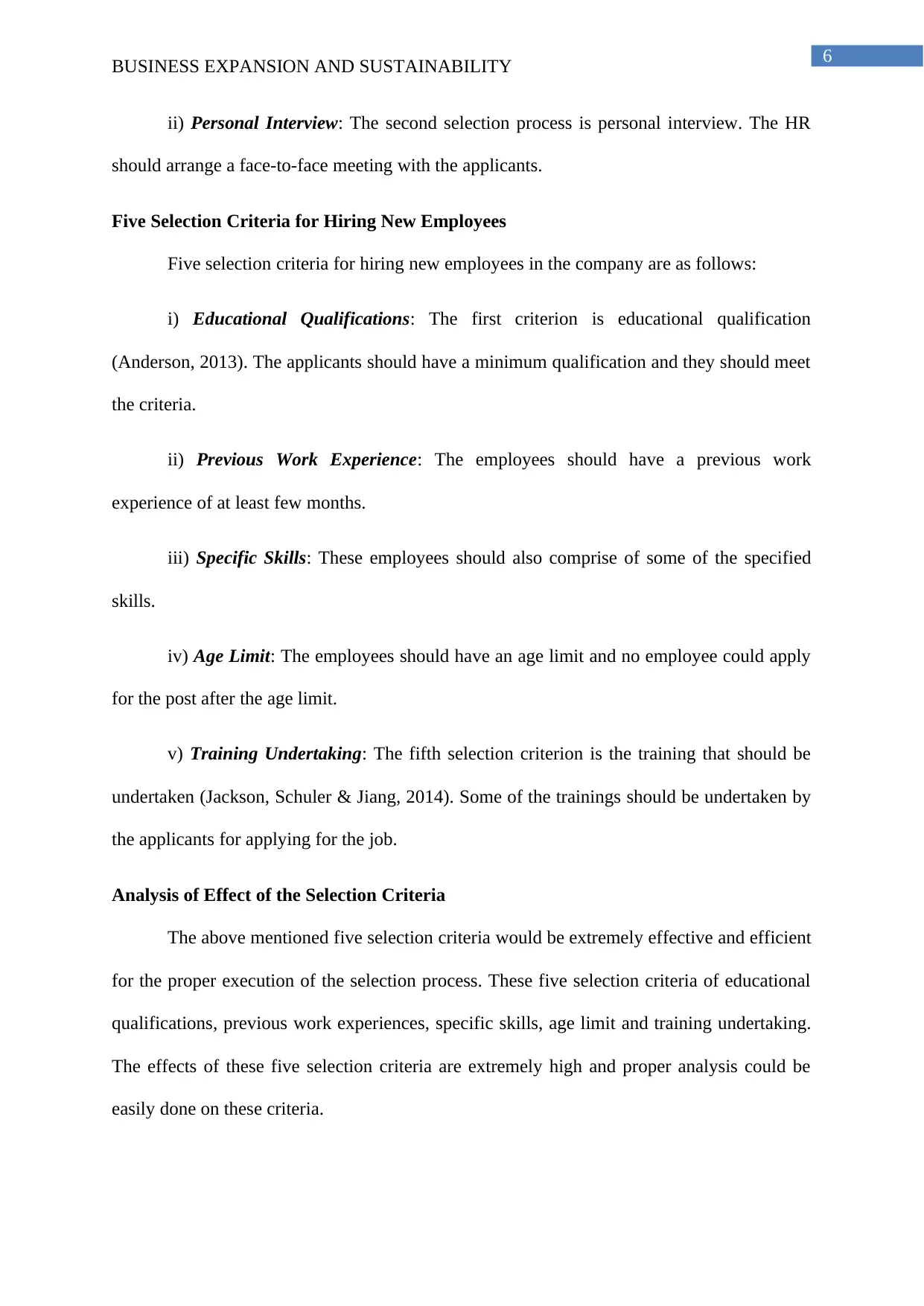
6
BUSINESS EXPANSION AND SUSTAINABILITY
ii) Personal Interview: The second selection process is personal interview. The HR
should arrange a face-to-face meeting with the applicants.
Five Selection Criteria for Hiring New Employees
Five selection criteria for hiring new employees in the company are as follows:
i) Educational Qualifications: The first criterion is educational qualification
(Anderson, 2013). The applicants should have a minimum qualification and they should meet
the criteria.
ii) Previous Work Experience: The employees should have a previous work
experience of at least few months.
iii) Specific Skills: These employees should also comprise of some of the specified
skills.
iv) Age Limit: The employees should have an age limit and no employee could apply
for the post after the age limit.
v) Training Undertaking: The fifth selection criterion is the training that should be
undertaken (Jackson, Schuler & Jiang, 2014). Some of the trainings should be undertaken by
the applicants for applying for the job.
Analysis of Effect of the Selection Criteria
The above mentioned five selection criteria would be extremely effective and efficient
for the proper execution of the selection process. These five selection criteria of educational
qualifications, previous work experiences, specific skills, age limit and training undertaking.
The effects of these five selection criteria are extremely high and proper analysis could be
easily done on these criteria.
BUSINESS EXPANSION AND SUSTAINABILITY
ii) Personal Interview: The second selection process is personal interview. The HR
should arrange a face-to-face meeting with the applicants.
Five Selection Criteria for Hiring New Employees
Five selection criteria for hiring new employees in the company are as follows:
i) Educational Qualifications: The first criterion is educational qualification
(Anderson, 2013). The applicants should have a minimum qualification and they should meet
the criteria.
ii) Previous Work Experience: The employees should have a previous work
experience of at least few months.
iii) Specific Skills: These employees should also comprise of some of the specified
skills.
iv) Age Limit: The employees should have an age limit and no employee could apply
for the post after the age limit.
v) Training Undertaking: The fifth selection criterion is the training that should be
undertaken (Jackson, Schuler & Jiang, 2014). Some of the trainings should be undertaken by
the applicants for applying for the job.
Analysis of Effect of the Selection Criteria
The above mentioned five selection criteria would be extremely effective and efficient
for the proper execution of the selection process. These five selection criteria of educational
qualifications, previous work experiences, specific skills, age limit and training undertaking.
The effects of these five selection criteria are extremely high and proper analysis could be
easily done on these criteria.
Paraphrase This Document
Need a fresh take? Get an instant paraphrase of this document with our AI Paraphraser
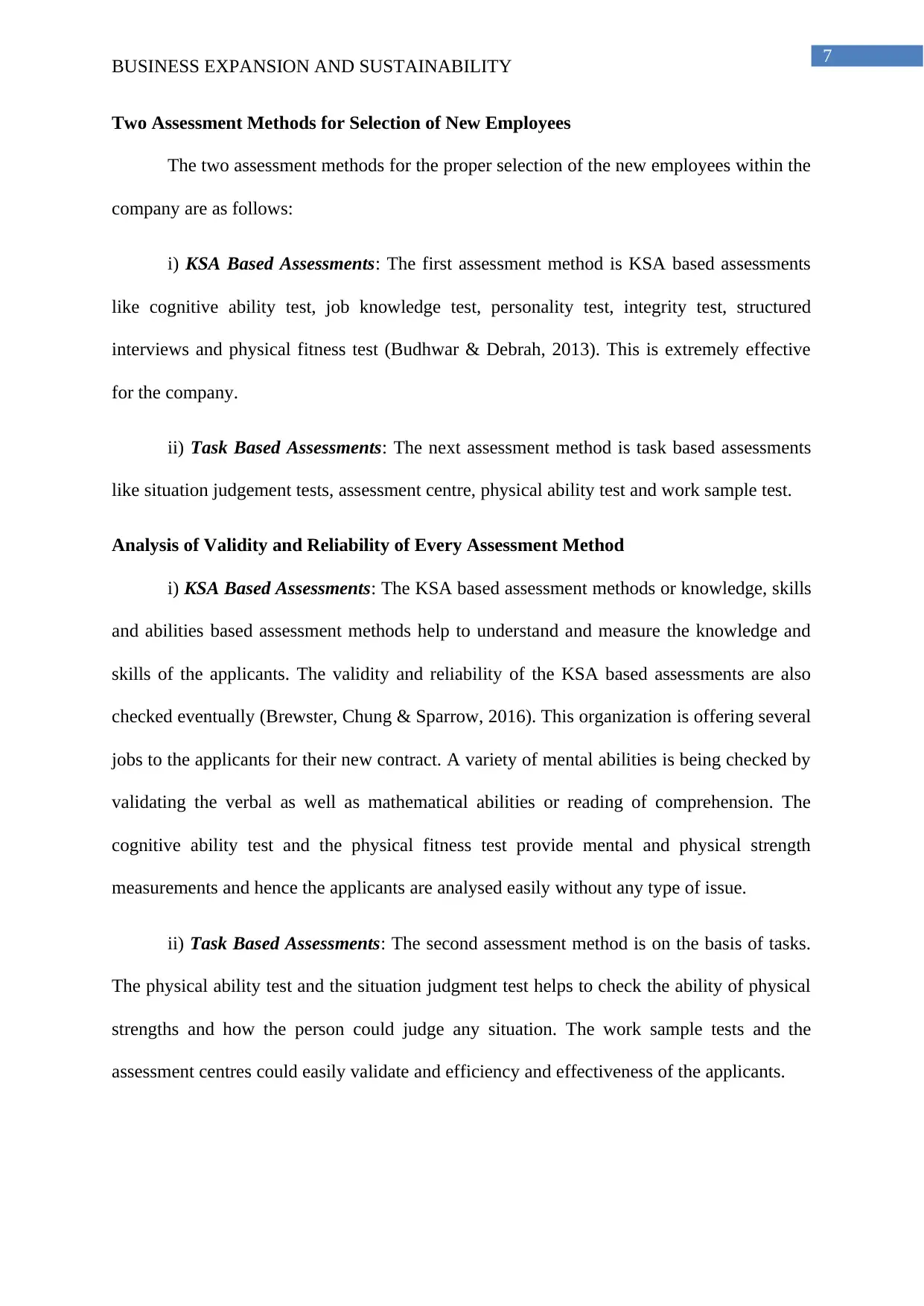
7
BUSINESS EXPANSION AND SUSTAINABILITY
Two Assessment Methods for Selection of New Employees
The two assessment methods for the proper selection of the new employees within the
company are as follows:
i) KSA Based Assessments: The first assessment method is KSA based assessments
like cognitive ability test, job knowledge test, personality test, integrity test, structured
interviews and physical fitness test (Budhwar & Debrah, 2013). This is extremely effective
for the company.
ii) Task Based Assessments: The next assessment method is task based assessments
like situation judgement tests, assessment centre, physical ability test and work sample test.
Analysis of Validity and Reliability of Every Assessment Method
i) KSA Based Assessments: The KSA based assessment methods or knowledge, skills
and abilities based assessment methods help to understand and measure the knowledge and
skills of the applicants. The validity and reliability of the KSA based assessments are also
checked eventually (Brewster, Chung & Sparrow, 2016). This organization is offering several
jobs to the applicants for their new contract. A variety of mental abilities is being checked by
validating the verbal as well as mathematical abilities or reading of comprehension. The
cognitive ability test and the physical fitness test provide mental and physical strength
measurements and hence the applicants are analysed easily without any type of issue.
ii) Task Based Assessments: The second assessment method is on the basis of tasks.
The physical ability test and the situation judgment test helps to check the ability of physical
strengths and how the person could judge any situation. The work sample tests and the
assessment centres could easily validate and efficiency and effectiveness of the applicants.
BUSINESS EXPANSION AND SUSTAINABILITY
Two Assessment Methods for Selection of New Employees
The two assessment methods for the proper selection of the new employees within the
company are as follows:
i) KSA Based Assessments: The first assessment method is KSA based assessments
like cognitive ability test, job knowledge test, personality test, integrity test, structured
interviews and physical fitness test (Budhwar & Debrah, 2013). This is extremely effective
for the company.
ii) Task Based Assessments: The next assessment method is task based assessments
like situation judgement tests, assessment centre, physical ability test and work sample test.
Analysis of Validity and Reliability of Every Assessment Method
i) KSA Based Assessments: The KSA based assessment methods or knowledge, skills
and abilities based assessment methods help to understand and measure the knowledge and
skills of the applicants. The validity and reliability of the KSA based assessments are also
checked eventually (Brewster, Chung & Sparrow, 2016). This organization is offering several
jobs to the applicants for their new contract. A variety of mental abilities is being checked by
validating the verbal as well as mathematical abilities or reading of comprehension. The
cognitive ability test and the physical fitness test provide mental and physical strength
measurements and hence the applicants are analysed easily without any type of issue.
ii) Task Based Assessments: The second assessment method is on the basis of tasks.
The physical ability test and the situation judgment test helps to check the ability of physical
strengths and how the person could judge any situation. The work sample tests and the
assessment centres could easily validate and efficiency and effectiveness of the applicants.
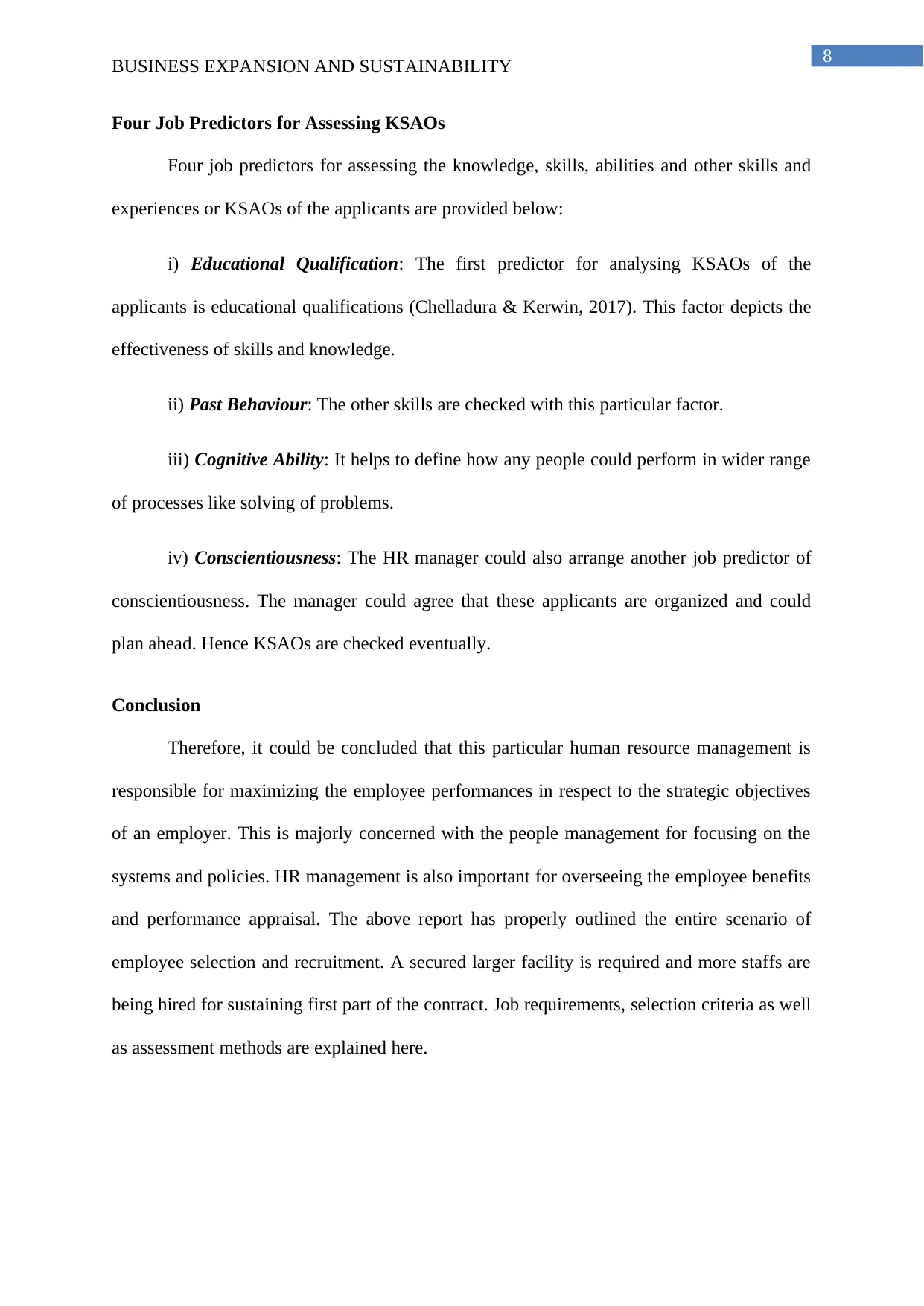
8
BUSINESS EXPANSION AND SUSTAINABILITY
Four Job Predictors for Assessing KSAOs
Four job predictors for assessing the knowledge, skills, abilities and other skills and
experiences or KSAOs of the applicants are provided below:
i) Educational Qualification: The first predictor for analysing KSAOs of the
applicants is educational qualifications (Chelladura & Kerwin, 2017). This factor depicts the
effectiveness of skills and knowledge.
ii) Past Behaviour: The other skills are checked with this particular factor.
iii) Cognitive Ability: It helps to define how any people could perform in wider range
of processes like solving of problems.
iv) Conscientiousness: The HR manager could also arrange another job predictor of
conscientiousness. The manager could agree that these applicants are organized and could
plan ahead. Hence KSAOs are checked eventually.
Conclusion
Therefore, it could be concluded that this particular human resource management is
responsible for maximizing the employee performances in respect to the strategic objectives
of an employer. This is majorly concerned with the people management for focusing on the
systems and policies. HR management is also important for overseeing the employee benefits
and performance appraisal. The above report has properly outlined the entire scenario of
employee selection and recruitment. A secured larger facility is required and more staffs are
being hired for sustaining first part of the contract. Job requirements, selection criteria as well
as assessment methods are explained here.
BUSINESS EXPANSION AND SUSTAINABILITY
Four Job Predictors for Assessing KSAOs
Four job predictors for assessing the knowledge, skills, abilities and other skills and
experiences or KSAOs of the applicants are provided below:
i) Educational Qualification: The first predictor for analysing KSAOs of the
applicants is educational qualifications (Chelladura & Kerwin, 2017). This factor depicts the
effectiveness of skills and knowledge.
ii) Past Behaviour: The other skills are checked with this particular factor.
iii) Cognitive Ability: It helps to define how any people could perform in wider range
of processes like solving of problems.
iv) Conscientiousness: The HR manager could also arrange another job predictor of
conscientiousness. The manager could agree that these applicants are organized and could
plan ahead. Hence KSAOs are checked eventually.
Conclusion
Therefore, it could be concluded that this particular human resource management is
responsible for maximizing the employee performances in respect to the strategic objectives
of an employer. This is majorly concerned with the people management for focusing on the
systems and policies. HR management is also important for overseeing the employee benefits
and performance appraisal. The above report has properly outlined the entire scenario of
employee selection and recruitment. A secured larger facility is required and more staffs are
being hired for sustaining first part of the contract. Job requirements, selection criteria as well
as assessment methods are explained here.
⊘ This is a preview!⊘
Do you want full access?
Subscribe today to unlock all pages.

Trusted by 1+ million students worldwide
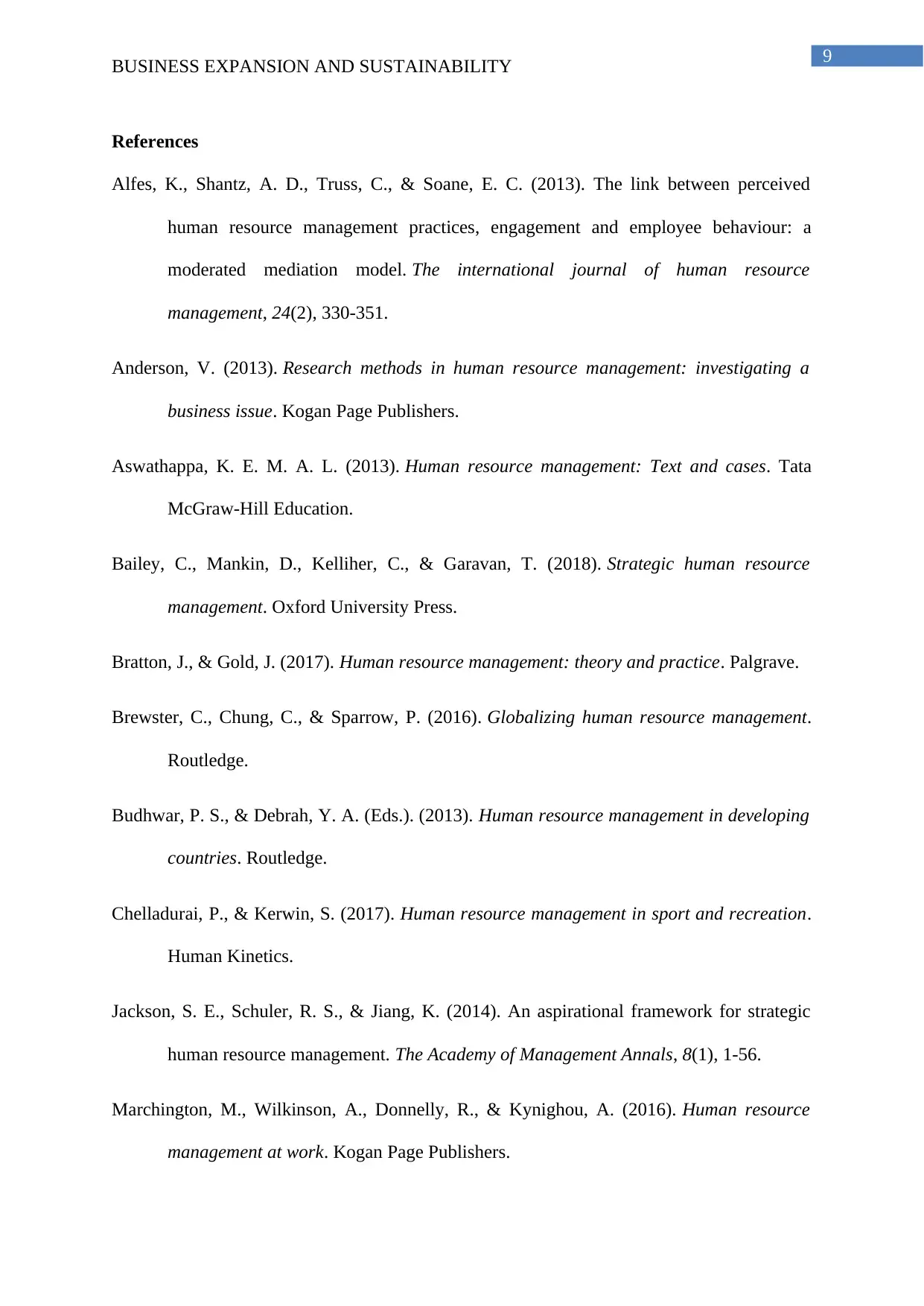
9
BUSINESS EXPANSION AND SUSTAINABILITY
References
Alfes, K., Shantz, A. D., Truss, C., & Soane, E. C. (2013). The link between perceived
human resource management practices, engagement and employee behaviour: a
moderated mediation model. The international journal of human resource
management, 24(2), 330-351.
Anderson, V. (2013). Research methods in human resource management: investigating a
business issue. Kogan Page Publishers.
Aswathappa, K. E. M. A. L. (2013). Human resource management: Text and cases. Tata
McGraw-Hill Education.
Bailey, C., Mankin, D., Kelliher, C., & Garavan, T. (2018). Strategic human resource
management. Oxford University Press.
Bratton, J., & Gold, J. (2017). Human resource management: theory and practice. Palgrave.
Brewster, C., Chung, C., & Sparrow, P. (2016). Globalizing human resource management.
Routledge.
Budhwar, P. S., & Debrah, Y. A. (Eds.). (2013). Human resource management in developing
countries. Routledge.
Chelladurai, P., & Kerwin, S. (2017). Human resource management in sport and recreation.
Human Kinetics.
Jackson, S. E., Schuler, R. S., & Jiang, K. (2014). An aspirational framework for strategic
human resource management. The Academy of Management Annals, 8(1), 1-56.
Marchington, M., Wilkinson, A., Donnelly, R., & Kynighou, A. (2016). Human resource
management at work. Kogan Page Publishers.
BUSINESS EXPANSION AND SUSTAINABILITY
References
Alfes, K., Shantz, A. D., Truss, C., & Soane, E. C. (2013). The link between perceived
human resource management practices, engagement and employee behaviour: a
moderated mediation model. The international journal of human resource
management, 24(2), 330-351.
Anderson, V. (2013). Research methods in human resource management: investigating a
business issue. Kogan Page Publishers.
Aswathappa, K. E. M. A. L. (2013). Human resource management: Text and cases. Tata
McGraw-Hill Education.
Bailey, C., Mankin, D., Kelliher, C., & Garavan, T. (2018). Strategic human resource
management. Oxford University Press.
Bratton, J., & Gold, J. (2017). Human resource management: theory and practice. Palgrave.
Brewster, C., Chung, C., & Sparrow, P. (2016). Globalizing human resource management.
Routledge.
Budhwar, P. S., & Debrah, Y. A. (Eds.). (2013). Human resource management in developing
countries. Routledge.
Chelladurai, P., & Kerwin, S. (2017). Human resource management in sport and recreation.
Human Kinetics.
Jackson, S. E., Schuler, R. S., & Jiang, K. (2014). An aspirational framework for strategic
human resource management. The Academy of Management Annals, 8(1), 1-56.
Marchington, M., Wilkinson, A., Donnelly, R., & Kynighou, A. (2016). Human resource
management at work. Kogan Page Publishers.
Paraphrase This Document
Need a fresh take? Get an instant paraphrase of this document with our AI Paraphraser
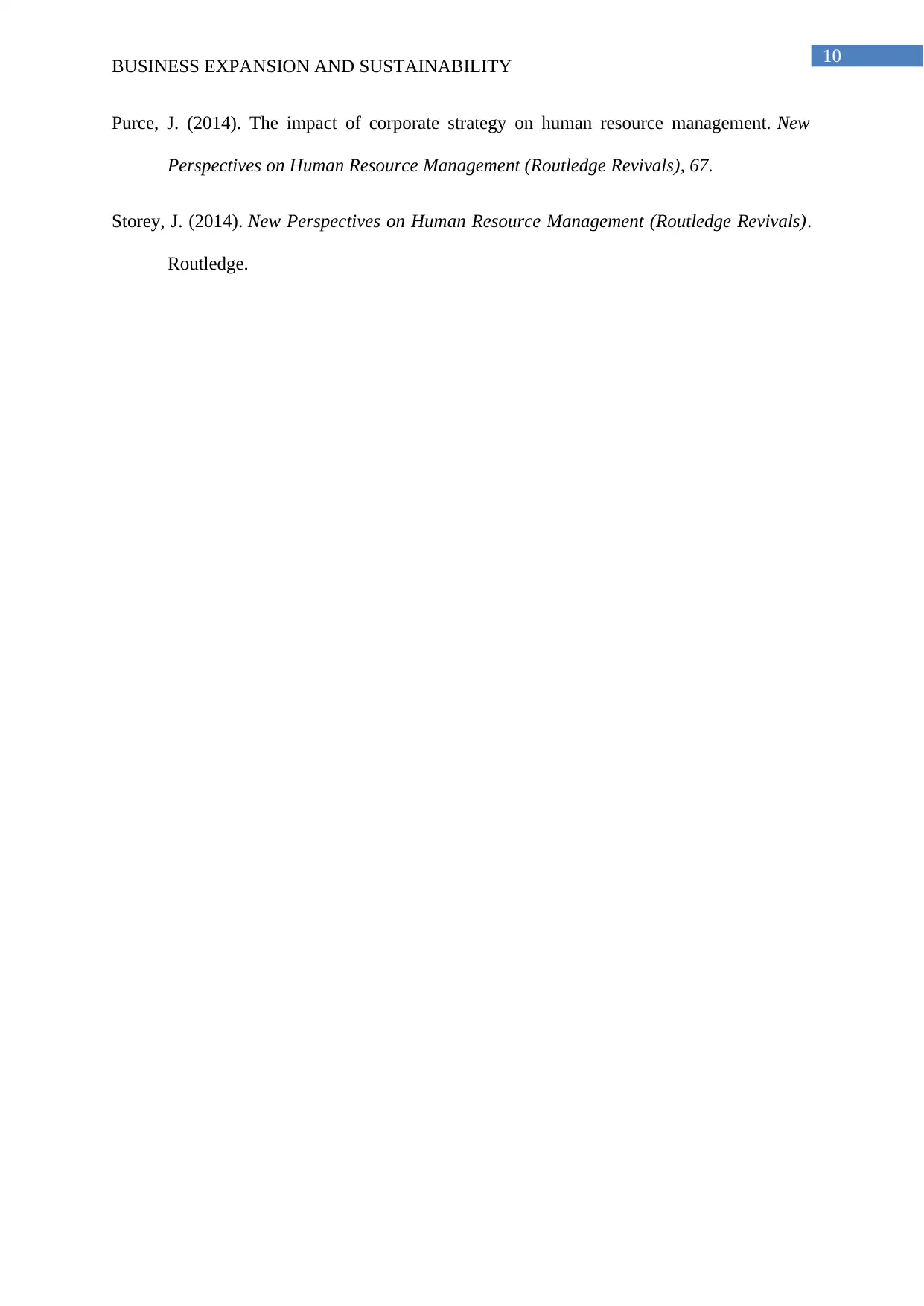
10
BUSINESS EXPANSION AND SUSTAINABILITY
Purce, J. (2014). The impact of corporate strategy on human resource management. New
Perspectives on Human Resource Management (Routledge Revivals), 67.
Storey, J. (2014). New Perspectives on Human Resource Management (Routledge Revivals).
Routledge.
BUSINESS EXPANSION AND SUSTAINABILITY
Purce, J. (2014). The impact of corporate strategy on human resource management. New
Perspectives on Human Resource Management (Routledge Revivals), 67.
Storey, J. (2014). New Perspectives on Human Resource Management (Routledge Revivals).
Routledge.
1 out of 11
Related Documents
Your All-in-One AI-Powered Toolkit for Academic Success.
+13062052269
info@desklib.com
Available 24*7 on WhatsApp / Email
![[object Object]](/_next/static/media/star-bottom.7253800d.svg)
Unlock your academic potential
Copyright © 2020–2025 A2Z Services. All Rights Reserved. Developed and managed by ZUCOL.





